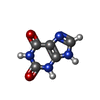[English] 日本語
 Yorodumi
Yorodumi- PDB-5grk: Crystal structure of Uracil DNA glycosylase -Xanthine complex fro... -
+ Open data
Open data
- Basic information
Basic information
| Entry | Database: PDB / ID: 5grk | ||||||
|---|---|---|---|---|---|---|---|
| Title | Crystal structure of Uracil DNA glycosylase -Xanthine complex from Bradyrhizobium diazoefficiens | ||||||
 Components Components | Blr0248 protein | ||||||
 Keywords Keywords | HYDROLASE / Uracil DNA glycosylase (UDG) Bradyrhizobium diazoefficiens / nitrogen fixing symbiont / DNA repair / Xanthine. | ||||||
| Function / homology | Uracil-DNA glycosylase-like domain superfamily / XANTHINE / Blr0248 protein Function and homology information Function and homology information | ||||||
| Biological species |  Bradyrhizobium diazoefficiens USDA 110 (bacteria) Bradyrhizobium diazoefficiens USDA 110 (bacteria) | ||||||
| Method |  X-RAY DIFFRACTION / X-RAY DIFFRACTION /  SYNCHROTRON / Resolution: 2.804 Å SYNCHROTRON / Resolution: 2.804 Å | ||||||
 Authors Authors | Patil, V.V. / Ullas, V.C. / Ahn, W. / Varshney, U. / Woo, E. | ||||||
 Citation Citation |  Journal: Nucleic Acids Res. / Year: 2017 Journal: Nucleic Acids Res. / Year: 2017Title: Uracil DNA glycosylase (UDG) activities in Bradyrhizobium diazoefficiens: characterization of a new class of UDG with broad substrate specificity Authors: Chembazhi, U.V. / Patil, V.V. / Sah, S. / Reeve, W. / Tiwari, R.P. / Woo, E. / Varshney, U. #1: Journal: NUCLEIC ACIDS RES. / Year: 2015 Title: A unique uracil-DNA binding protein of the uracil DNA glycosylase superfamily Authors: Sang, P.B. / Srinath, T. / Patil, A.G. / Woo, E. / Varshney, U. | ||||||
| History |
|
- Structure visualization
Structure visualization
| Structure viewer | Molecule:  Molmil Molmil Jmol/JSmol Jmol/JSmol |
|---|
- Downloads & links
Downloads & links
- Download
Download
| PDBx/mmCIF format |  5grk.cif.gz 5grk.cif.gz | 386.7 KB | Display |  PDBx/mmCIF format PDBx/mmCIF format |
|---|---|---|---|---|
| PDB format |  pdb5grk.ent.gz pdb5grk.ent.gz | 323.3 KB | Display |  PDB format PDB format |
| PDBx/mmJSON format |  5grk.json.gz 5grk.json.gz | Tree view |  PDBx/mmJSON format PDBx/mmJSON format | |
| Others |  Other downloads Other downloads |
-Validation report
| Summary document |  5grk_validation.pdf.gz 5grk_validation.pdf.gz | 458 KB | Display |  wwPDB validaton report wwPDB validaton report |
|---|---|---|---|---|
| Full document |  5grk_full_validation.pdf.gz 5grk_full_validation.pdf.gz | 469.5 KB | Display | |
| Data in XML |  5grk_validation.xml.gz 5grk_validation.xml.gz | 37.5 KB | Display | |
| Data in CIF |  5grk_validation.cif.gz 5grk_validation.cif.gz | 49.4 KB | Display | |
| Arichive directory |  https://data.pdbj.org/pub/pdb/validation_reports/gr/5grk https://data.pdbj.org/pub/pdb/validation_reports/gr/5grk ftp://data.pdbj.org/pub/pdb/validation_reports/gr/5grk ftp://data.pdbj.org/pub/pdb/validation_reports/gr/5grk | HTTPS FTP |
-Related structure data
- Links
Links
- Assembly
Assembly
| Deposited unit | 
| ||||||||
|---|---|---|---|---|---|---|---|---|---|
| 1 | 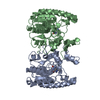
| ||||||||
| 2 | 
| ||||||||
| Unit cell |
|
- Components
Components
| #1: Protein | Mass: 29725.795 Da / Num. of mol.: 4 Source method: isolated from a genetically manipulated source Source: (gene. exp.)  Bradyrhizobium diazoefficiens USDA 110 (bacteria) Bradyrhizobium diazoefficiens USDA 110 (bacteria)Strain: USDA 110 / Gene: blr0248 / Production host:  #2: Chemical | ChemComp-XAN / Has protein modification | Y | |
|---|
-Experimental details
-Experiment
| Experiment | Method:  X-RAY DIFFRACTION / Number of used crystals: 1 X-RAY DIFFRACTION / Number of used crystals: 1 |
|---|
- Sample preparation
Sample preparation
| Crystal | Density Matthews: 3.38 Å3/Da / Density % sol: 63.6 % |
|---|---|
| Crystal grow | Temperature: 291 K / Method: vapor diffusion, sitting drop / pH: 4 Details: 20% PEG3350, 200 mM sodium citrate, 100 mM sodium citrate/citric acid |
-Data collection
| Diffraction | Mean temperature: 93 K |
|---|---|
| Diffraction source | Source:  SYNCHROTRON / Site: PAL/PLS SYNCHROTRON / Site: PAL/PLS  / Beamline: 5C (4A) / Wavelength: 0.97934 Å / Beamline: 5C (4A) / Wavelength: 0.97934 Å |
| Detector | Type: ADSC QUANTUM 270 / Detector: CCD / Date: Feb 26, 2016 |
| Radiation | Protocol: SINGLE WAVELENGTH / Monochromatic (M) / Laue (L): M / Scattering type: x-ray |
| Radiation wavelength | Wavelength: 0.97934 Å / Relative weight: 1 |
| Reflection | Resolution: 2.804→47.174 Å / Num. obs: 40422 / % possible obs: 99.91 % / Redundancy: 13.2 % / Net I/σ(I): 15.13 |
| Reflection shell | Resolution: 2.8→2.85 Å |
- Processing
Processing
| Software | Name: PHENIX / Version: 1.9_1692 / Classification: refinement | |||||||||||||||||||||||||||||||||||||||||||||||||||||||||||||||||||||||||||||||||||||||||||||||||||||||||
|---|---|---|---|---|---|---|---|---|---|---|---|---|---|---|---|---|---|---|---|---|---|---|---|---|---|---|---|---|---|---|---|---|---|---|---|---|---|---|---|---|---|---|---|---|---|---|---|---|---|---|---|---|---|---|---|---|---|---|---|---|---|---|---|---|---|---|---|---|---|---|---|---|---|---|---|---|---|---|---|---|---|---|---|---|---|---|---|---|---|---|---|---|---|---|---|---|---|---|---|---|---|---|---|---|---|---|
| Refinement | Resolution: 2.804→47.174 Å / SU ML: 0.33 / Cross valid method: FREE R-VALUE / σ(F): 1.37 / Phase error: 25.75 / Stereochemistry target values: ML
| |||||||||||||||||||||||||||||||||||||||||||||||||||||||||||||||||||||||||||||||||||||||||||||||||||||||||
| Solvent computation | Shrinkage radii: 0.9 Å / VDW probe radii: 1.11 Å / Solvent model: FLAT BULK SOLVENT MODEL | |||||||||||||||||||||||||||||||||||||||||||||||||||||||||||||||||||||||||||||||||||||||||||||||||||||||||
| Refinement step | Cycle: LAST / Resolution: 2.804→47.174 Å
| |||||||||||||||||||||||||||||||||||||||||||||||||||||||||||||||||||||||||||||||||||||||||||||||||||||||||
| Refine LS restraints |
| |||||||||||||||||||||||||||||||||||||||||||||||||||||||||||||||||||||||||||||||||||||||||||||||||||||||||
| LS refinement shell |
|
 Movie
Movie Controller
Controller


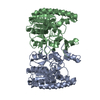







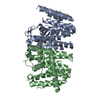

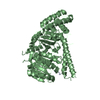
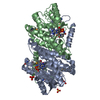
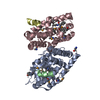
 PDBj
PDBj
